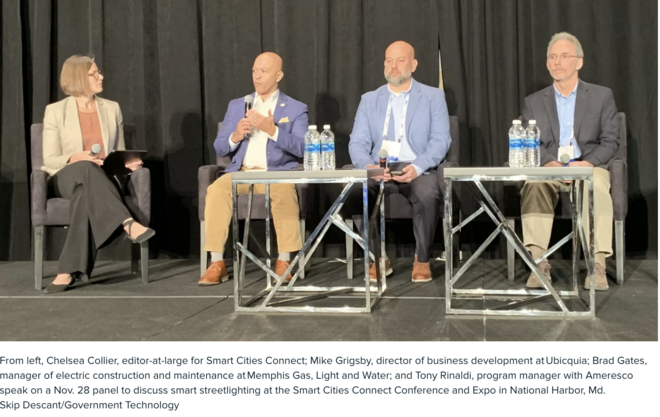Watch for AI to Find Its Way Into Smart City Upgrades

Government Technology
As cities update timeless technology like streetlights, they are laying the groundwork for smart city connectivity and data gathering. Artificial intelligence will help sift through the mounds of data these projects create.
It should come as no surprise that artificial intelligence is making its way into the smart city space as the mechanism for sifting the massive amounts of data that urban tech requires and generates.
Generative AI can test, explain, generate, audit and translate code, said Alison Brooks, research vice president for Worldwide Public Safety at International Data Corporation (IDC), a consulting company for the IT, telecommunications and consumer technology markets.
In her comments at the Smart Cities Connect Conference and Expo last week in National Harbor, Md., Brooks pointed to generative AI’s ability to create compelling summaries of dense data. “Think about [city] council notes and complaint records, and policing, and the generation of outreach to citizens. All of those things are fairly low risk and are fairly high value.”
The technology, Brooks said, “is going to play an increasingly important role in government service delivery.”
A survey by IDC concluded 62 percent of government respondents said they would use an AI element in a citizen call center services and support application.
“And that makes sense, because you’re just augmenting existing knowledge,” Brooks remarked, adding, 36 percent of those surveyed would like to use AI to further personalize government service delivery.
“This usability factor is really what it’s about. It’s like so easy,” she added. “We’re really going to be seeing that generative AI is going to be integrating in the same way that you’re seeing ChatGPT. We’re seeing it’s going to be integrating workflows and data from multiple applications. It will save employees time from mundane tasks.”
Using AI to crunch data will not likely be lost on city technologists as they deploy digital infrastructure to manage parking, traffic or other features of modern city life. Countless municipalities have upgraded infrastructure like streetlights, transitioning these to LEDs, sure, but have also taken the opportunity to deploy smart city sensors and other devices at scale.
“Smart lighting is about as close to a no-brainer smart city project as you can get,” said Mike Grigsby, director of business development at Ubicquia.
Cities like Memphis, Tenn., are in the final stages of upgrading all 84,000 of its streetlights to LEDs with smart controls, a project that will pay for itself in about 10 years through energy and maintenance savings, officials say.
Upgrading the lighting technology opens the door to adding a wealth of smart city applications.
“You can do pedestrian counting, you can do car counting … . You can get air-quality monitors on. You can put public Wi-Fi on there. And so, now you begin to have this kind of entry component into the smart city space,” said Grigsby. “You’re talking tens of thousands of nodes across the entirety of the city landscape.”
“Smart streetlighting has moved into this kind of smart city infrastructure level,” echoed Chelsea Collier, editor-at-large for Smart Cities Connect, and moderator of the streetlighting panel. “Where we’re talking about public safety. We’re talking about the impact on equity, and of course, energy savings and the impact on environment."
Technologies like smart infrastructure will be increasingly turned to as cities seek to address big concerns like climate change or resiliency, said Brooks. And all of this data will need to be understood and harnessed for jobs across departments, another area where generative AI can step in.
“We need to be able to share infrastructure and data,” she added. “But to do that, there needs to be more coordination across departments, across capabilities, across use cases. And it has to be driving all of that with a future strategy to point us to that North Star.”
See original article here.

